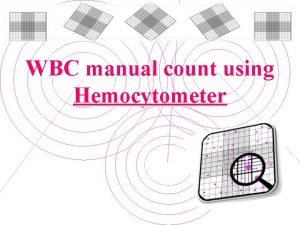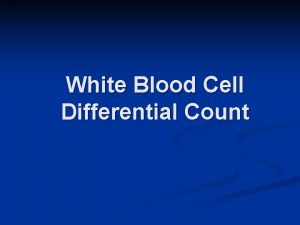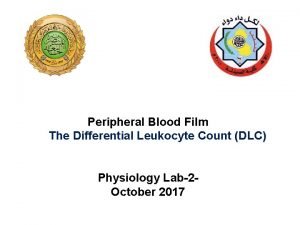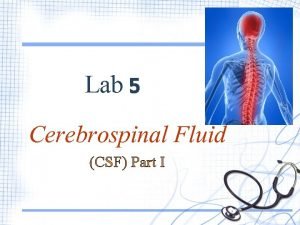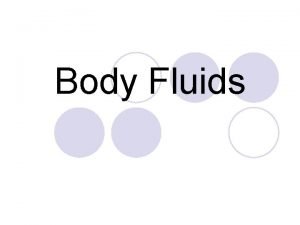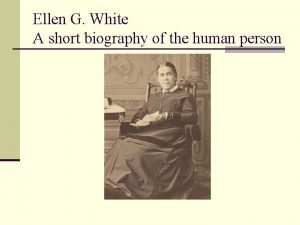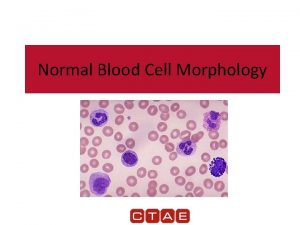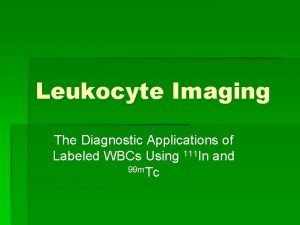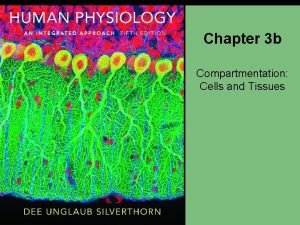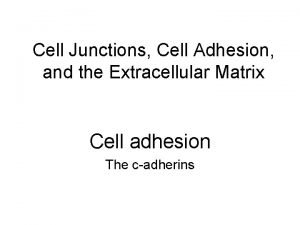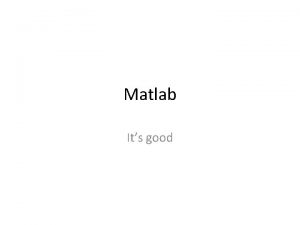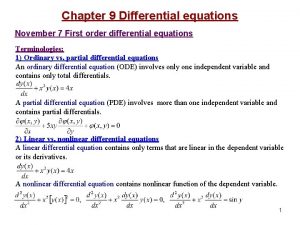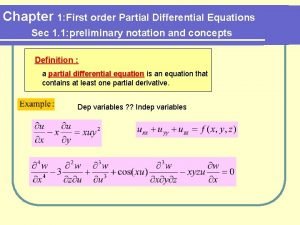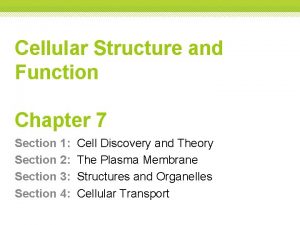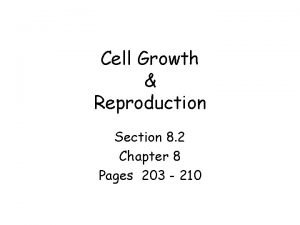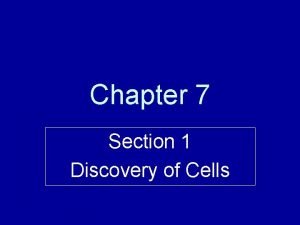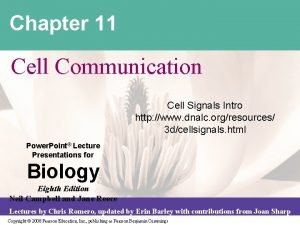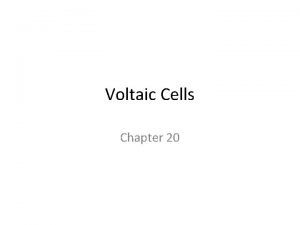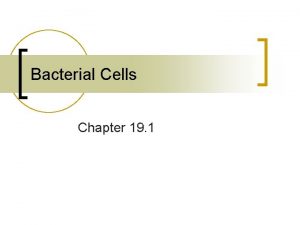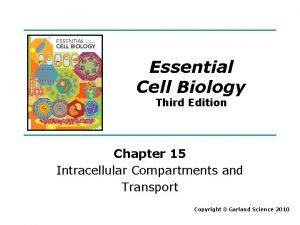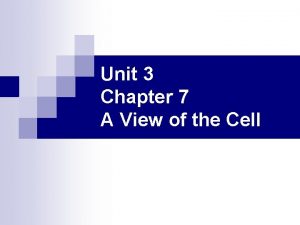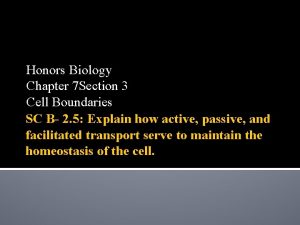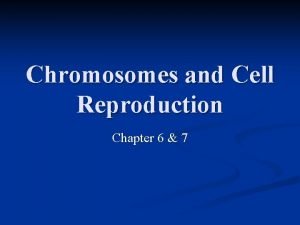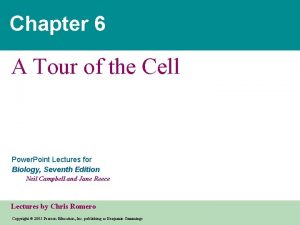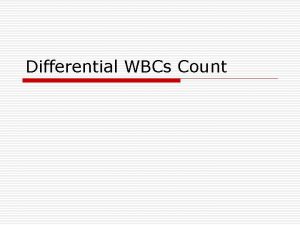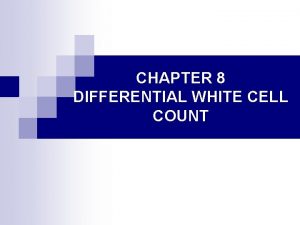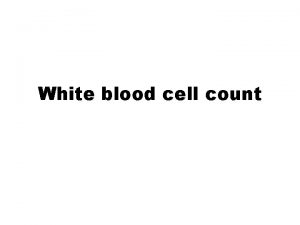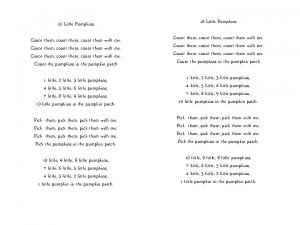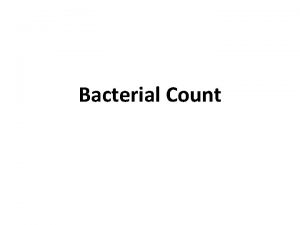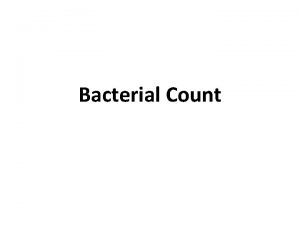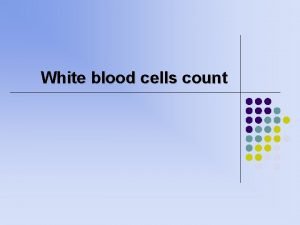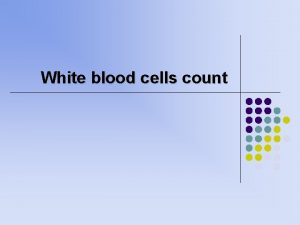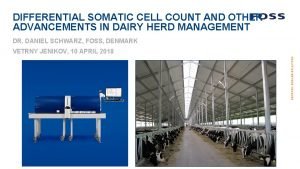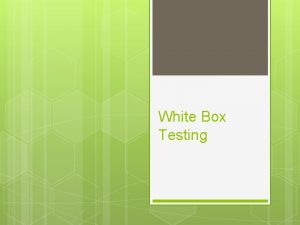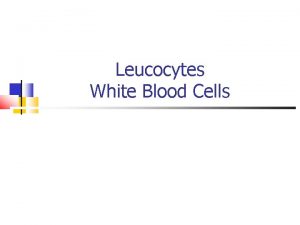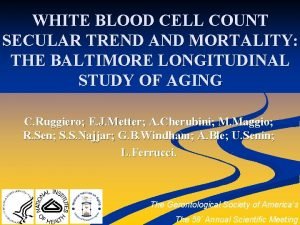CHAPTER 8 WHITE CELL DIFFERENTIAL COUNT Acknowledgements n



































































- Slides: 67

CHAPTER 8 WHITE CELL DIFFERENTIAL COUNT

Acknowledgements n n n n Addisa Ababa University Jimma University Hawassa University Haramaya University of Gondar American Society for Clinical Pathology Center for Disease Control and Prevention-Ethiopia

Objectives After completion of this chapter, the students will be able to: n Define differential leukocyte count (DLC) n Discuss the general features to be considered in the DLC n Identify each type of white cells morphologically n Perform a 100 cell differential count n Define a relative white cell count and absolute white cell count n Perform WBC and platelet estimate on a stained peripheral blood smear

Objectives cont’d n n n Discuss the clinical implications of the differential leukocyte count Identify mature and immature leukocytes Identify morphological abnormalities of leukocytes Identify reactive lymphocytes, including clinical situations associated with their presence Identify possible sources of error and their remedies in DLC Perform QC in DLC

Outline n n n n Introduction Clinical significance Methods of counting Evaluating staining properties Reporting the White Cell Differential Count Interpretation of White Cell Differential Count QC in DLC

8. 1 Introduction i. White Cell Differential Count: ¨ Is n n the enumeration of the relative proportions (percentages) of the various types of white cells as seen in stained blood films ¨ Is used to determine the relative numbers of each type of leukocyte. A smear is examined and each time a leukocyte is seen, it is both tallied and classified on a special counter The counting and classifying continues until 100 cells have been observed

Diff count cont’d n n The differential cell count also includes: ¨ an evaluation of RBC morphology, ¨ platelet morphology and numbers, and ¨ general WBC morphology and estimation With a manual differential count, inaccuracy or deviation from the true count results both from: ¨ maldistribution ¨ misidentification of cells

Diff count cont’d n n n Maldistribution of cells ¨ The different types of white cell are not distributed evenly over a slide ¨ The tail of the film contains: § more neutrophils § fewer lymphocytes, N. B. monocytes are fairly evenly distributed along the length of the film Large cells are preferentially distributed at the edges of the film Maldistribution of cells is aggravated: ¨ if a film is too thin or ¨ if a spreader with a rough edge has been used

Diff count cont’d ii. Clinical significance of Diff count n To correlate the distribution of different leukocytes present in the circulation with different disease conditions

Diff count cont’d iii. Principle of White Cell Differential Count n After taking blood sample, blood film is prepared, and after staining with Romanowsky stains, 100, 200, 300, etc. , cells will be counted; then the percent distribution of each cell is calculated iv. Type of specimen: EDTA anticoagulated venous or capillary blood v. Equipment and Reagents ¨ Microscope ¨ Diff counter ¨ Oil immersion

8. 2. Methods of Counting n Various methods of tracking over a slide have been proposed to attempt to overcome errors due to maldistribution: ¨ The Longitudinal Strip Method ¨ The Battlement (Lateral strip, crenellation) Method ¨ The Modified (Exaggerated) Battlement Method

A. The Longitudinal Strip Method n n n This is a method of tracking along the length of the film The cells are counted using the 40 x dry or 100 x oil immersion objectives in a strip running the whole length of the film until 100 cells are counted. If all the cells are counted in such a strip, the differential totals will approximate closely to the true differential count

Longitudinal strip method cont’d Advantage and Disadvantages of the Method: Advatage: n It compensates for maldistribution between the body and the tail Disadvantage n It does not compensate for maldistribution between the centre and the edge ¨ i. e. , It does not allow for inclusion of neutrophils and monocytes at the edges of the film

Longitudinal strip method cont’d Disadv cont’d n Difficulty in identifying contracted heavily stained cells in the thicker parts of the film (head part) ¨ However, this problem is minimized in a well made film and in practice brings little difference to results

B. The Battlement Method Counting is performed by moving from side to side across the width of the slide in the counting area just behind the feather edge where the cells are separated from one another and are free from artifacts. Advantage n It compensates for maldistribution between the centre and the edge Disadvantage n It does not compensates for maldistribution between the body and the tail ¨ since the customary 100 -cell differential count will not cover a very large proportion of the length of the blood film n

C. The Modified Battlement Method n n In modified battlement method, two fields are counted close to the edge parallel to the edge of the film, then four fields at right angles, then two fields parallel to the edge and so on. A modified battlement track is a compromise between the two methods. At least 100 cells should be counted. If there is white cell aggregation, the maldistribution of cells is so great that an accurate differential count is impossible.

Cont. . n n Of the three methods ¨ the lateral strip method appears to be the method of choice because it averages out almost all of the disadvantages of the two other methods Multiple manual registers or electronic counters are used for the count.

Diff count cont’d Note: All elements of the blood film must be observed while performing the differential count. If any abnormality is seen in the smear, it should be confirmed and reported The following points should be checked: n ¨ Erythrocytes: size, shape, distribution, and degree of hemoglobinization ¨ presence of inclusion bodies ¨ presence of nucleated red cells, if so, the total leukocyte count must be corrected

Diff count cont’d n n n Platelets: ¨ Estimation (10 -20/HPF) ¨ Do they look normal? ¨ are there many giant or bizzare forms? Leukocytes: · Mature? Immature? Atypical? · Average number of lobes? hypersegmented neutrophils? Hyposegmentation? · Hypergranulated ones? vacuolation? · Toxic granulation, other inclusions · Estimation · etc Hemoparasites: · malaria, borrelia, babesia, etc.

Diff count cont’d vi. Procedure n Using the 10 x dry objective, scan the smear for: ¨ Proper staining ¨ WBC distribution ¨ Presence of platelet clumps ¨ Presence of light blue fibrin strands which may indicate that the blood was not well mixed or partially clotted ¨ Any other unusual or irregular characteristics of cells n Using the 40 x dry objective, perform WBC estimate (see Table below) Platelet Clump

Performing a WBC Estimate Under 40 x High Dry n n n Look for estimate area which has 200 RBCs that are partially overlapping with many single red cells Determine a WBC estimate using the following conversion information (hpf=high power field): ¨ 2 -4 cells/hpf = 4. 0 – 7. 0 x 109/L Remember! ¨ 4 -6 cells/hpf = 7. 0 – 10. 0 x 109/L Estimates ¨ 6 -10 cells/hpf = 10. 0 – 13. 0 x 109/L are not 9 ¨ 10 -20 cells/hpf = 13. 0 – 18. 0 x 10 /L reported! Estimates: ¨ are reported as decreased, Increased, or adequate ¨ are used for QC purpose

Procedure cont’d n n n Locate a thin area of the smear in which the RBCs are evenly distributed, only slightly overlap, and the central pallor or “whites-of-their-eyes” is seen Place a drop of oil on the slide and switch to the oil immersion objective Change the objective to 100 x oil immersion Count 100 white cells including all cell lines from immature to mature Properly record and report results of differential cell counts. Note reference ranges and any abnormal results.

Evaluating Staining Properties n n n Locate a cell that can be positively identified, such as a polysegmented neutrophil. Note the staining characteristics of the nucleus and cytoplasmic granules. Relate these features to any unidentified cells that may be present.

Evaluating Staining Properties cont’d n n Myelocytes and metamyelocytes, if present, are recorded separately from neutrophils. Band (stab) cells are generally counted as neutrophils but it may be useful to record them separately. ¨ An increase may point to an inflammatory process even in the absence of an absolute leucocytosis.

Evaluating Staining Properties cont’d n n Remember that cells don’t always appear “picture” perfect. The actual staining color of cells may vary from what is seen in textbooks or even in images.

Segmented Neutrophil Approximately 40 -75% in peripheral blood n 2 -5 lobes of nucleus n Joined by thin filament n Faint pink cytoplasm sprinkled with pink or purple neutrophilic granules n

Small Lymphocyte n n n Approximately 40% in peripheral smear Small round nucleus, clumpy, chunk chromatin pattern Notice the monocyte on the top right

Large Lymphocyte n n n Large lymphocytes are often confused with monocytes Remember - the lymphocyte nuclear chromatin is compact, with blocks of chromatin The nuclear shape may be round, oval or indented

Monocyte n n n Approximately 5% in peripheral smear Large, convoluted, brainy looking nucleus with lacy looking chromatin Pale, gray blue, ground glass cytoplasm (numerous fine azurophilic granules) Monocyte nucleus can sometimes take many shapes from a band shape, to an oblong shape, to a convolutes brainy shape. What is important to remember is that the chromatin is lace, open weaved, and foamy looking.

Monocytes vs. Lymphocytes n n n Monocytes and lymphocytes are often confused The chromatin pattern of the monocyte is light purple and arranged in loose, lacy or linear strands The nucleus may be round, lobulated or folded

Basophil n n Approximately 0 -2% in peripheral blood Nucleus is bi-lobed and obscured by granules Cytoplasm is pale, washed out and contains intense large blue black granules Granules are scattered throughout the cell and it is hard to distinguish any distinct nuclear characteristics.

Eosinophil n n n Approximately 2 -7% in peripheral blood Bi-lobed or banded nucleus Large, red-orange and distinct granules To identify the eosinophil rely on the granules. The granules are very individualized looking. If the stain is right, then the cell will look red orange. If not, the cell will be washed-out looking.

What Does a Normal Adult Blood Smear Look Like? Segmented neutrophils ~60% Lymphocytes ~30% Monocytes ~5% Eosinophils, Basophils n ~3 -5% Remember, percentages are approximate and may differ with ethnic groups and in disease conditions What normal cell has not been discussed?

What About Bands? n n This cell (also called a stab) is a precursor cell to the segmented neutrophil The nucleus is C-shaped or horseshoe shaped containing no filament and has no tight or pinched constriction Cytoplasm is pink gray with granules Approximately 2 -6% in normal differential ¨ If unsure of identification, classify as a more mature cell, the segmented neutrophil

What About Immature Granulocytes? n n Metamyelocytes Myelocytes Promyelocytes Myeloblasts

Metamyelocyte n n n Also called a juvenile Rarely seen normally in the peripheral blood Nucleus characteristically indented or kidney-shaped The nuclear chromatin is clumped and condensed Specific granules appear the same as in the band

Metamyelocyte (bottom) and Band (top)

Myelocyte n n n Should never be seen in the peripheral blood The nucleus is round or oval and often eccentrically located in the cell The nuclear chromatin is beginning to clump; no nucleoli are visible A moderate amount of patchy blue cytoplasm can be seen The cell is characterized by the presence of light pink or tan (neutrophilic) specific granules

Myeloctes

Promyelocyte n n n Should never be seen in the peripheral blood Large cell The nucleus may be eccentric and slightly indented with nucleoli still visible The nuclear chromatin is loose and open The cell is characterized by the presence of few to many, prominent, dark red or purple cytoplasmic granules

Promyelocyte

Myeloblast n n n Should never be seen in the peripheral blood Large cell (size may vary) The nucleus is large and round, with one or more visible nucleoli The nuclear chromatin is loose and open The cytoplasm is scanty to moderate and deeply basophilic

Myeloblast

Abnormal Inclusions in Granulocytes (Neutrophils) n n n Toxic granulation Dohle bodies Vacuoles

Toxic Granulation n Large, blue-black or deep purple granules in the cytoplasm of neutrophils Represent primary or “azurophilic” granules Seen associated with acute infections, drug poisoning and burns

Dohle Bodies n n Small, round or oval light-blue staining areas in the cytoplasm of neutrophils Represent aggregates of rough endoplasmic reticulum Seen in patients with infections, burns and after exposure to cytotoxic agents May also be seen in conjunction with toxic granulation

Vacuoles n n Clear areas or “holes” in the cytoplasm of neutrophils Seen when the neutrophilic cytoplasm begins to degenerate or if the cell has been actively phagocytic Seen in patients with infections and can be noted along with toxic granulation and Dohle bodies N. B. Also can be seen as an artifact associated with old EDTA anticoagulated blood

Toxic Granules Dohle body Vacuoles

Reactive Changes in Lymphocytes n Response to a variety of viral and non-viral stimuli produce diverse nuclear and/or cytoplasmic changes in the lymphocytes ¨ Associated with viral infections, e. g. , Epstein-Barr virus (EBV), cytomegalovirus (CMV), human immunodeficiency virus (HIV) ¨ Also seen in response to drugs or non-viral organisms such as toxoplasmosis

Reactive Lymphocytes n Characteristics: ¨ Irregular shape of cytoplasm and/or nucleus ¨ Abundant dark blue cytoplasm, overall bigger cell ¨ Cytoplasmic tags, sharp ridges; scalloped by red cells ¨ Increased number of reddish granules or vacuoles in cytoplasm ¨ Fine nuclear chromatin pattern; may see nucleoli

Reactive Lymphocytes

8. 3. Reporting the White Cell Differential Count n n n The differential leukocyte count expressed as the percentage of each type of cell It should be related to the total leukocyte count The results reported in absolute numbers as the absolute value gives better clinical indication

Absolute vs. Relative Count Absolute count n Derived by multiplying the percentage of the identified cell times the white cell count ¨ If 40% lymphs are counted and the white cell count is 5. 0 x 109/L then the absolute lymphocyte count is 5. 0 x 109/L x 0. 4 or 2. 0 x 109/L ¨ This number is then compared to the healthy reference range Relative count n Strictly the percent counted in the WBC differential ¨ The relative number is then compared to the reference range for normal white cell differentials ¨ So, it is possible for an individual to have a relative increase, an absolute increase and a relative and absolute increase of a particular cell

Approximate Absolute and Relative Reference Ranges Values may vary according to geographic location Healthy Adult Cell Type Absolute Relative Segmented Neutrophil 2. 0 -7. 0 x 109/L 40. 0 -75. 0% Lymphocyte 1. 5 -4. 5 x 109/L 20 -45% Monocyte 0. 2 -0. 8 x 109/L 2 -10% Eosinophil 0. 04 -0. 4 x 109/L 0 -7% Basophil 0. 02 -0. 1 x 109/L 0 -2%

Quality control n n n Quality control Well prepared well stained blood film which has 3 zones (Head, body, tail) WBC should contain blue nucleus along with a lighter staining cytoplasm RBC should have good quality of color ranging from buff pink to orange Platelet should be blue with granules and no nucleus

Sources of error n n Use of unclean slide and improper smear preparation and staining technique Counting cells in an area not suitable for counting Misidentification of white cells Interpersonal skill

8. 4. Interpretation of White Cell Differential Count n n For proper interpretation the relative count is of little use by itself For example, the fact that a sample may have 60% polymorphs is of little use A patient sample may have 60% neutrophil and a total leukocyte count of 8. 0 x 109/L giving 4. 8 x 109/L neutrophils, which is quite normal but if the patient has 60% neutrophils in a total leucocyte count of 3. 0 x 109/L, then the patient’s neutrophil count is 1. 8 x 109/L neutrophils. In this case the patient has granulocytopenia.

Interpretation cont’d 1. Neutrophil 1. 1 Neutrophilia/neutrophilic leucocytosis: ¨ an increase in the number of circulating neutrophils above normal (>2. 0 -7. 0 x 109/L) ¨ Overwhelming infections ¨ Metabolic disorders: uremia, diabetic acidosis ¨ Drugs and chemicals: lead, mercury, potassium chlorate ¨ Physical and emotional stress ¨ Hematological disorders: myelogenous leukemia ¨ Tissue destruction or necrosis: burns, surgical operations

Interpretation cont’d 1. 2. Neutropenia: n a reduction of the absolute neutrophil count below 2. 0 x 109/L ¨ Myeloid hypoplasia ¨ Drugs (chloramphenicol, phenylbutazone) ¨ Ionizing radiation 1. 3. Hypergranular neutrophils (neutrophils with toxic granules): these are ¨ neutrophils with coarse blue black or purple granules. ¨ indicative of severe infection or other toxic conditions.

Interpretation cont’d. . 1. 4 Vacuolation ¨ seen in progressive muscular dystrophy 1. 5. Hypersegmentation: ¨ neutrophils with more than six lobes to their nucleus (as many as ten or twelve may be seen) ¨ indicative of megaloblastic erythropoiesis (vitamin B 12 and/or folic acid deficiency), iron deficiency anemia and uremia. 1. 6. Agranular Neutrophils: ¨ neutrophils devoid of granules ¨ having a pale blue cytoplasm( features of leukemia)

Interpretation cont’d 2. Eosinophil 2. 1. Eosinophilia: ¨ an eosinophil count above 0. 5 x 109/L ¨ Occurs during: n Allergic diseases: bronchial asthma, seasonal rhinitis n Intestinal parasitic infections: e. g. trichinosis, taeniasis n Skin disorders n Chronic myelogenous leukemia

Interpretation cont’d 2. 2. Eosinopenia: ¨ an eosinophil count below 0. 04 x 109/L ¨ Occurs during: n Acute stress due to secretion of adrenal glucocorticoid and epinephrine n Acute inflammatory states 3. Basophilia: ¨ a basophil count above 0. 2 x 109/L ¨ Rare condition ¨ Occurs during: n Allergic reactions n Chronic myelogenous leukemia n Polycythemia vera

Interpretation cont’d 4. Monocyte 4. 1. Monocytosis: ¨ a monocyte count above 1. 0 x 109/l ¨ Occurs during n Recovery from acute infections n Tuberculosis n Monocytic leukemia 4. 2. Monocytopenia: ¨ a monocyte count below 0. 2 x 109/l ¨ Occurs during n Treatment with prednisone n Hairy cell leukemia

Interpretation cont’d 5. Lymphocytes 5. 1. Lymphocytosis: ¨ absolute lymphocyte count above 4. 0 x 109/L in adults and above 8. 0 x 109/L in children. ¨ Seen during n Infectious lymphocytosis associated with coxackie virus n Other viral infections: Epstein-Barr virus, cytomegalovirus n Acute and chronic lymphocytic leukemia n Toxoplasmosis

Interpretation cont’d 5. 2. Lymphocytopenia: ¨ a lymphocyte count below 1. 0 x 109/l in adults and below 3. 0 x 109/l in children ¨ Seen in n Immune deficiency disorders: HIV/AIDS n Drugs, radiation therapy Atypical lymphocytes: ¨ Large cell; abundant pale blue cytoplasm with peripheral basophilia, may have azurophilic granules ¨ They are primarily seen infectious mononucleosis which is an acute, selflimiting infectious disease of the reticuloendothelial tissues, especially the lymphatic tissues

Summary: Performing Differential Cell Counts n n n Use properly prepared and stained blood smears Establish a good counting area Properly identify white cells Provide an estimate of total white cells and platelets Record cellular morphology (RBC, WBC, and Plt) Properly record and report results noting reference ranges and abnormal results

Review Questions 1. 2. 3. 4. 5. Define differential leukocyte count. What is the importance of reporting the differential leukocyte counts in absolute number? What other elements of the blood film should be evaluated while doing the differential leukocyte count? Describe three tracking methods of diff counting with their advantage and disadvantage List at least five factors affecting the White Cell Differential Count and their remedies
 Hemocytometer calculation for wbc
Hemocytometer calculation for wbc Wbc
Wbc Dlc in physiology
Dlc in physiology Hills like white elephants lyrics
Hills like white elephants lyrics The scientist mathias schleiden studied _______ in ______.
The scientist mathias schleiden studied _______ in ______. Lights criteria
Lights criteria Function of cerebrospinal fluid
Function of cerebrospinal fluid Body fluid
Body fluid Base represents totality
Base represents totality Issa mood meaning
Issa mood meaning Ellen g white biography
Ellen g white biography White blood cell size
White blood cell size Type of white blood cell
Type of white blood cell White blood cell organelles
White blood cell organelles Disida scan
Disida scan Cell city project animal cell
Cell city project animal cell Advantages and disadvantages of diaphragm cell process
Advantages and disadvantages of diaphragm cell process Prokaryotic cell vs eukaryotic cell
Prokaryotic cell vs eukaryotic cell Prokaryotic
Prokaryotic Animal cell plant cell venn diagram
Animal cell plant cell venn diagram Spontaneity electrochemistry
Spontaneity electrochemistry Dry cell vs wet cell
Dry cell vs wet cell Venn diagram for animal and plant cells
Venn diagram for animal and plant cells Middle lamella
Middle lamella Plant cell structure
Plant cell structure Animal vs plant cell
Animal vs plant cell Cell wall cell membrane
Cell wall cell membrane 10 cm dish surface area
10 cm dish surface area Cell line vs cell strain
Cell line vs cell strain Cell city analogy answer key
Cell city analogy answer key Types of secondary cells
Types of secondary cells Differences between plant animal and bacterial cells
Differences between plant animal and bacterial cells Cell-cell junction
Cell-cell junction Cell-cell junction
Cell-cell junction Which organelle prepares proteins for specific jobs
Which organelle prepares proteins for specific jobs Events of the cell cycle
Events of the cell cycle Prokaryotic cell and eukaryotic cell
Prokaryotic cell and eukaryotic cell Carbohydrate side chain
Carbohydrate side chain Cell organelles structures and functions organizer
Cell organelles structures and functions organizer Idealized plant cell
Idealized plant cell Walker cell and hadley cell
Walker cell and hadley cell Prokaryotic vs eukaryotic cells worksheet
Prokaryotic vs eukaryotic cells worksheet Cell cycle and cell division
Cell cycle and cell division Biology.arizona.edu/cell bio/activities/cell cycle/01.html
Biology.arizona.edu/cell bio/activities/cell cycle/01.html Cell cycle chart
Cell cycle chart Cell contents assignment to a non-cell array object
Cell contents assignment to a non-cell array object Chapter 21 electrochemistry
Chapter 21 electrochemistry Animal cell and plant cell
Animal cell and plant cell First order differential equation chapter 9
First order differential equation chapter 9 Highest order chapter 1
Highest order chapter 1 What does blood consist of
What does blood consist of Signal transduction
Signal transduction Chapter 7 section 4 cellular transport
Chapter 7 section 4 cellular transport Section 8-2 cell division
Section 8-2 cell division Chapter 7 section 1 cell discovery and theory
Chapter 7 section 1 cell discovery and theory Eukaryotic cell structure
Eukaryotic cell structure 3 stages of signal transduction pathway
3 stages of signal transduction pathway Chapter 7 cell structure and function section review 7-2
Chapter 7 cell structure and function section review 7-2 Chapter 5 cell structure and function
Chapter 5 cell structure and function Cell chapter 20
Cell chapter 20 Staphylobacillus
Staphylobacillus Chapter 21 electrochemistry
Chapter 21 electrochemistry 2010
2010 What organelle looks like a stack of pancakes
What organelle looks like a stack of pancakes Chapter 7-3 cell boundaries
Chapter 7-3 cell boundaries Cell biology third edition
Cell biology third edition Chapter 6 chromosomes and cell reproduction
Chapter 6 chromosomes and cell reproduction Chapter 6 a tour of the cell answers
Chapter 6 a tour of the cell answers
